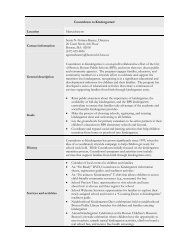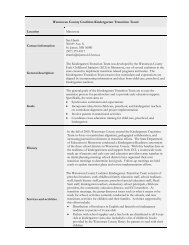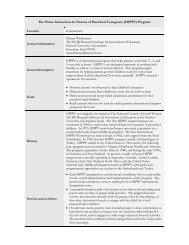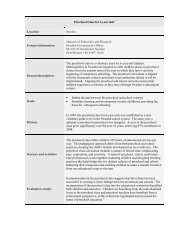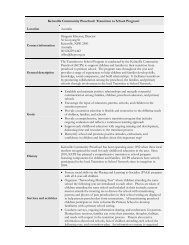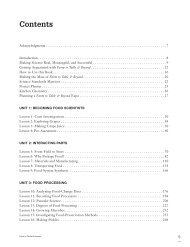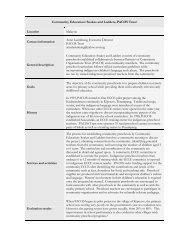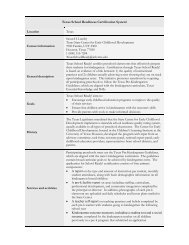Proceedings of the Fourth Annual Teachers College Educational ...
Proceedings of the Fourth Annual Teachers College Educational ...
Proceedings of the Fourth Annual Teachers College Educational ...
Create successful ePaper yourself
Turn your PDF publications into a flip-book with our unique Google optimized e-Paper software.
information and <strong>the</strong> world according to <strong>the</strong>ir personal reality; <strong>the</strong>y learn by observation, processing and<br />
interpretation, and <strong>the</strong>n personalize <strong>the</strong> information into personal knowledge.<br />
Learners learn best when <strong>the</strong>y can contextualize what <strong>the</strong>y learn, both for immediate application<br />
and to acquire personal meaning. Mobile learning facilitates personalized learning because<br />
learning (and collaboration) from any place and at any time allows <strong>the</strong> learning to be<br />
contextualized (Attewell & Savill-Smith, 2004, p.6).<br />
With a mobile learning opportunity in mind, as best practice is being informed and perhaps even defined<br />
by emergent research findings in educational neuroscience, corporate e-learning may be wise to invest in<br />
adult learning strategies that harness <strong>the</strong> power <strong>of</strong> what neuroscience is calling "Emotionally Cogent<br />
Stimuli--or ECS". The Black C<strong>of</strong>fee Brand Expressionists define Emotionally Cogent Stimuli (ECS) as an<br />
object, sensation, situation or o<strong>the</strong>r stimulus that triggers an emotional response. Anecdotally, as<br />
advertised, <strong>the</strong>y help companies design meaningful brand experiences by helping organizations improve<br />
how <strong>the</strong>y deliver value. Likewise, as practitioners and scholars <strong>of</strong> learning it is our social responsibility to<br />
design instruction that harnesses <strong>the</strong> power <strong>of</strong> emotionally cogent stimuli for <strong>the</strong> learners optimal learning<br />
experience.<br />
Neuroscience has recently identified that what moves our learners to mobilize communication in <strong>the</strong> book<br />
store, fitness center, cafe, and even lavatory are called emotionally competent stimuli (ECS) which have<br />
been described as <strong>the</strong> most powerfully processed external stimuli ever measured (Immordino-Yang &<br />
Faeth, 2010; Medina, 2008; Zull, 2011).Specifically, emotionally competent stimuli appear to excite<br />
learning by engage <strong>the</strong> brain’s reticular activating system, a network <strong>of</strong> nerve pathways connecting lower<br />
and higher brain regions. These powerful stimuli, when circularly relevant construct and reinforce<br />
neuronal pathways between sensory and analytical regions in <strong>the</strong> brain (Immordino-Yang & Faeth, 2010;<br />
Medina, 2008; Willis, 2010). Research also suggests that <strong>the</strong> brain’s cerebral cortex is responsible for<br />
conscious and non-conscious thought processes which direct volition and action (Feinstein, 2006). In this<br />
way, ECS in higher education and corporate e-learning programs can work tacitly or overtly to help<br />
learners feel that <strong>the</strong>y have to access <strong>the</strong>ir mobile devices to learn more in <strong>the</strong> presence <strong>of</strong> a community<br />
<strong>of</strong> practice. Such program designs will indeed signal a departure from <strong>the</strong> longstanding, behavioristic<br />
premises upon which much instruction has been practiced. And still brain research is suggesting that<br />
behaviorism alone is insufficient for activating <strong>the</strong> reticular activating system’s green light that signals<br />
emotionally competent stimuli to be encoded by positive neurotransmitters and <strong>the</strong>n wired into <strong>the</strong><br />
prefrontal, analytical cortex. This is a different kind <strong>of</strong> mobile learning pedagogy in a prevailing digital era.<br />
It <strong>of</strong>fers neuroscientific insights into <strong>the</strong> physiology <strong>of</strong> learning.<br />
So as <strong>the</strong> 21st century higher education and corporate America market place finds itself in <strong>the</strong> midst <strong>of</strong> a<br />
nexus <strong>of</strong> <strong>the</strong> most connected populace ever, <strong>the</strong> opportunity—and perhaps responsibility—belongs to <strong>the</strong><br />
staff in academia and corporate America to design neuroscientifically guided, emotionally cogent elearning<br />
programs, so that <strong>the</strong> most connected populace ever will feel itself moved to cross <strong>the</strong> threshold<br />
<strong>of</strong> ubiquitous communication to ubiquitous optimal learning. So to what extent are our e-learning<br />
programs rich and moving? So moving that <strong>the</strong>y must be acted upon even across <strong>the</strong> formerly sacred<br />
thresholds <strong>of</strong> <strong>the</strong> lunchroom and <strong>the</strong> lavatory, where few electronic academic exchanges are observed.<br />
This paper’s proposition is that when adult learners feel so moved to text, message, and access courses<br />
because <strong>of</strong> <strong>the</strong>ir powerfully moving nature from <strong>the</strong>se telltale spaces, higher education and corporate elearning<br />
will cross <strong>the</strong> threshold <strong>of</strong> program relevance, and in doing so, mobilize 21 st century learning<br />
through emotionally cogent stimuli.<br />
60



